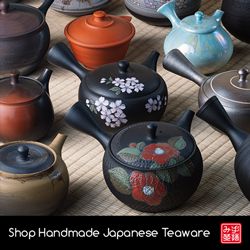 If you like to buy different Japanese teas online, you may have run across teas that are made with the “zairai cultivar”. What kind of tea cultivar is it?
If you like to buy different Japanese teas online, you may have run across teas that are made with the “zairai cultivar”. What kind of tea cultivar is it?
Zairai (在来) means “native” in Japanese, and in tea it’s used to mean an old tea tree of no identifiable cultivar.
Is zairai a cultivar?
Not in the strict sense of the word.
Cultivars are essentially clones, because the tea plants are grown from cuttings (instead of seeds) so that the characteristics remain the same.
With zairai (sometimes also known as yamacha), each tea tree has very different traits because it came from a seed. They are all collectively known as zairai, but they aren’t really a cultivar.
Characteristics of zairai tea plants
Many of the zairai tea plants are very old, hundreds of years in fact. Unless it’s an old zairai tea field, where the tea plants are regularly trimmed, they have grown into tea trees.
Although only about half as productive as the bushes from the Yabukita cultivar, this trees are quite resistant to pests and have very deep roots. Their leaves have a higher mineral content, and teas made from these leaves are considered to be rare.
Very few zairai tea fields are left. If you look closely at the zairai tea plants in a tea field, you’ll notice that the leaves are different from each other in many ways: flavor, aroma, shape, color, etc. It’s considered a natural blend!
Unfortunately, this lack of uniformity in zaira’s aracha leaves usually results in a lower price when compared to aracha from established cultivars. It’s a shame, because it’s an incentive to erradicate zairai tea plants in favor of popular cultivars.
The only way to experience the taste of tea in old Japan, is to drink one made from a zairai tea plant. It’s a historic asset that will hopefully be preserved forever.
I encourage you to try it!





November 21, 2013
All clones are from cultivars, but not all cultivars are clones. Zairai is pretty much a VERY old cultivar that has had time to go feral – much like the “Wild Arbor” cultivars in Yunnan province, China.
I’ve had a few Zairai arachas. VERY tasty. Different from other sencha out there.
November 21, 2013
Hi Geoff, thanks for the comment.
The problem with Zairai is that it’s a very broad group. Some tea trees are way much older than others (and thus the flavor changes), and Zairai tea plants from different parts of Japan show a good diversity in many aspects. As much as you would find with modern cultivars.
November 23, 2013
Didn’t know it was a blanket group of cultivars. I just thought it was one strain. So it IS like the “arbor” delineation in China.
February 11, 2014
Hi Ricardo,
Had met quite a few farmers in various prefectures and invariably all of them seem to be thinking of having a small plot dedicated to Zairai (在来). Few of them had already started on it.
Perhaps this is a new thinking that is emerging in Japan. I think they want some differentiation in their teas and also as an insurance for any calamity (genetic or disease etc) in future.
March 17, 2018
Zairai cannot be a cultivar due to its genetic diversity. It is more if a landrace where original wild trees were cultivated in Japan and have gone feral.
Zairai can be compared to Camellia taliensus in China which is also considered by some to be a wild tree. Both zairai and taliensus are probably ancient species once cultivated and gone feral.
My money is on zairai being a landrace like a crab apple gone wild.
April 6, 2020
My lab has just sequenced the genome of Camellia taliensis (not yet published), which is a very close relative of Camellia sinensis. C. taliensis is mostly composed of wild trees, but there are some recent efforts in China to domesticate it as a plantation tree. C. taliensis leaves have been used for a while to make black and white teas, and it is also used to make a highly valued Pu’er tea. I agree with Clifford that zairai of Japan are probably feral (that is, trees gone wild from domestic plants originally brought from China). My lab in the US could confirm this if I was able to get some leaves of zairai and cultivars from Japan. Ricardo says there is a 2002 paper on this topic using DNA markers to analyze origins (which could be definitive), but I have not been able to find this article.
April 6, 2020
Hi Jeff, thank you for your comment.
Here’s the article:
https://www.ncbi.nlm.nih.gov/pubmed/12582605